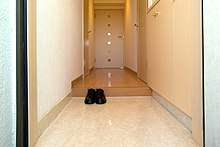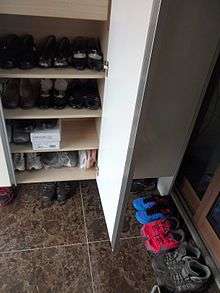Tradition of removing shoes in the home and houses of worship
In many cultures there is a tradition of removing one's shoes in the home and places like church, temples and schools.


Background
In religions originating in the Indian subcontinent and in the Middle East, it is customary to remove one's shoes when entering a house of worship. In the Bible, God commanded Moses to remove his sandals before approaching Him on Mount Sinai.[1] The Eastern cultural context of this narrative regards shoes as bringing in dust into the home and removing one's shoes "would be a way of recognizing one's personal uncleanness in the presence of holiness."[1] Hinduism and Islam also regard feet as being unclean; it is considered sacrilegious to touch books with one's feet and an insult to point one's feet at someone.[2] As such, in many mandirs and mosques, as well as in churches and synagogues of the Indian subcontinent and Middle East, it is customary for worshippers to remove their shoes before entering a house of worship, where they believe they are entering into the presence of the divine.[2]
In the world
Europe
Germany, Austria and Northern Europe
In Northern Europe and Austria, it is generally considered rude or unhygienic to keep one's shoes on when entering a house, in particular boots or outdoor walking shoes. There may be exceptions, especially when it is a short visit where it is not necessary to enter the interior rooms of the house or flat.
UK, Ireland, Netherlands
In the Netherlands, people decide for themselves if they take their shoes off or not unless they are having visitors. In the United Kingdom, whether shoes are taken off is at the homeowner's discretion and both options are common. However, it is uncommon for people to walk around barefoot. In Ireland, however, it is very uncommon to take one's shoes off when entering a house, especially for visitors.
Southwestern Europe
In Spain and Portugal, it is normal to enter a home with shoes on. They are only removed in rare cases, such as for a wooden floor. In France, most people will remove their shoes when entering a house, but some will keep them on.
Eastern Europe
In Eastern Europe, including all Slavic countries (Russia, Ukraine, Poland, etc.), Hungary, Romania, and Moldova, most people will take off their shoes at home and will expect visitors to do so, unless it is a formal meeting or a social event. When in doubt, people will usually ask if they can keep their shoes on. When at home, some people will walk barefoot while others will wear slippers (this often depends on the type of floor covering, e.g. carpets vs wooden floor). It is common for schoolchildren to have a special pair of shoes for wearing at school, especially in winter. Some people will have a special pair of shoes for wearing at work, especially in winter. In restaurants, shops, theatres, and museums shoes are not taken off. Shoes are not taken off in churches.
Southeastern Europe (Balkans)
In Southeastern Europe (former Yugoslavia, Albania, Bulgaria, Greece), people traditionally remove their shoes and either walk barefoot or wear indoor slippers at home, especially in winter. Shoes are kept on in churches, as well as most other public indoor spaces, but they are removed in mosques.
In Turkey, most people traditionally remove their shoes before entering any house. Students or employees never remove their shoes before entering their buildings (schools, workplaces, etc.). The only practice of removing shoes outside the home is before entering "inside" the mosque; however, people never remove shoes when in a mosque's courtyard or garden.
In former Yugoslavia, keeping one's shoes on indoors is generally frowned upon as rude and unhygienic, and visitors that venture beyond the entry hallway are expected to remove them. It is considered good manners for the host to provide their guest with indoor slippers, especially in winter. However, it is often inconvenient for deliverymen to remove their shoes, especially if carrying heavy items. To ensure hygiene is not compromised, rugs and similar floor coverings are moved out of the way beforehand, and the route the deliverymen are expected to take is covered with newspaper or cardboard, to protect the flooring. Preschool classrooms are invariably carpeted, to facilitate play, so indoor shoes are an essential school item. Schools generally require for these to be closed slip-on or zippered shoes, designed for indoor use. From the first grade onward, the classrooms feature hard flooring, and outdoor shoes are kept on. Outdoor shoes are also generally worn at work, but some workplaces may allow, or even require, their employees to either wear indoor footwear, such as slippers, or regular outdoor shoes reserved for indoor use.
Asia
India, Thailand, Korea, Taiwan, Vietnam, Philippines, Malaysia, Japan, Singapore, Indonesia, Laos, Cambodia, Pakistan, Afghanistan, Myanmar, Bhutan, Bangladesh, Kazakhstan and to a lesser degree China typically follow this tradition of removing shoes before entering a house.
In Pakistan, Afghanistan and other countries where having carpeted rugs are common, it is necessary to take one's shoes off for this.
China
In China, it is common to put on indoor slippers after taking one's shoes off. Winter slippers can be constructed of cloth and summer slippers are usually made of plastic or rubber. In social reunions or parties at houses, guests are not always demanded to take their shoes off, especially in big celebrations such as the Chinese New Year, when the number of guests in a house is frequently superior to the number of slippers available for guests.
Iran
In Iran, this is a widespread tradition. Cleanliness of a home is very important for families. It is also common to remove shoes in kindergarten schools and, although rarely, in some small private businesses.
Israel
Only some Israelis remove their shoes at home. During the Priestly Blessing in the synagogue, the kohanim (priests) will remove their shoes.
India
In India, it is the widespread norm to take shoes off when entering the home. It may even be considered rude for guests to keep their shoes on inside the house.
Japan
In Japan, the genkan, an entryway area to a house, apartment, or building, is where outdoor shoes are removed, and where one changes into uwabaki, indoor slippers. In addition, there are separate toilet slippers (トイレスリッパ, toire surippa) into which one changes before entering the toilet from the rest of the house. The outdoors and the toilet area are both considered unclean spaces. The indoors is considered a clean space. One must change into appropriate footwear before entering the corresponding spaces.
Malaysia
In Malaysia, it is common practice to remove shoes before entering any house or apartment. More modern folks will have indoor slippers. Some temples like Batu Caves and religious places such as mosques and suraus require the removal of shoes before entering. Modern schools require students to remove their shoes before entering classrooms, labs, library or carpeted spaces. Students still wear shoes at more open spaces such as sports courts, halls or in the corridors as these areas are still more exposed to the elements since Malaysian schools are mostly open to allow natural airflow due to the warm weather. Some private offices exercise the removal of shoes, especially on carpeted floors.
Vietnam
In Vietnam, it is a custom to remove shoes before entering any house or flat. It is also common to remove shoes in kindergarten schools and in some small private businesses.
Arab world
In the Arab world, no shoes are allowed indoors, as the shoes' soles are seen as dirty and unsanitary.
Thailand
Nearly all the houses or apartments in Thailand require removing shoes and placing them in front of the main door to enter. One also needd to remove their shoes to enter some buildings in Thai temples, especially in Ubosot. Kindergarten schools and some buildings in old elementary or high schools also require students to take off their shoes as well.
However, in some houses or schools, slippers are allowed, but those are not allowed outside the buildings, as well in some restrooms there are provided sandals for changing before entering restrooms to keep it clean.
America
United States
In the United States, taking shoes off indoors is not a tradition within the Continental United States, but is considered expected in Hawaii, Alaska, Guam, and the Northern Mariana Islands. It is also prevalent in the Northeast due to poor weather in the winter, as well as in the Pacific Northwest, with standards differing from household to household. In New England, many elementary schools require students to bring an indoor pair of shoes as well as winter boots. This is especially the case during rainy weather, when one's shoes could easily get very muddy, wet, or dirty. However, removing of shoes is common among certain immigrant communities.
Canada
In Canada, it is generally the rule to take off one's shoes when entering a person's home, to avoid tracking dirt and grime on the floor, although exceptions do exist.
Some specialized medical facilities require patients to remove shoes in order to maintain cleanliness.
In office settings, workers usually wear indoor shoes in the winter. However outdoor shoes are worn in office settings in the summer.
References
- Lioy, Daniel (2008). KJV International Bible Lesson Commentary: The New Standard in Biblical Exposition Based on the International Sunday School Lessons (ISSL). David C. Cook. p. 321. ISBN 978-1-4347-9975-3.
- DeMello, Margo (2009). Feet and Footwear: A Cultural Encyclopedia. ABC-CLIO. p. 34. ISBN 978-0-313-35715-2.
- Lo scarpisfero
- Living in Canada? Take your shoes off.
- Jews and Shoes
- Arab culture: the insult of the shoe